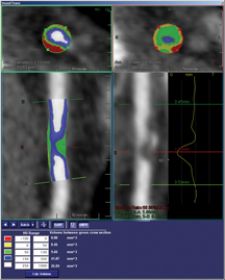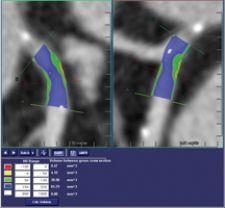
TeraRecon's AQPlaque analyzes the production of a histogram of voxel values along the defined section of vessels, enabling researchers to identify the presence of disease.
Moving from film to digital has dramatically improved efficiencies in imaging organizations. Now organizations are blending their RIS, PACS and clinical algorithms to further improve workflow and operations. This improvement creates new opportunities for radiologists and the business environments in which they work, but it also creates several challenges.
Integration and ever-changing workflow
Today’s newest solutions go beyond basic interfacing of RIS and PACS to provide single-desktop access to all information required for reading and reporting. This streamlines workflow by eliminating the cumbersome task of the radiologist toggling between separate solutions.
In a true RIS/PACS integration, the entire radiology organization must understand that the new environment will be centered on an exam-driven workflow experience. Careful planning is required to create this environment. For example, a radiologist would historically be handed a paper requisition and then “look for” the images either in a stack of films or in their PACS. In truly integrated RIS/PACS environments, radiologists must break this habit because they are automatically presented an ordered exam and the priors that go with it in the convenience of a single interface. The radiologist saves significant time and avoids busywork because he or she no longer searches for images to match the paper requisition.
While this provides efficiency improvements, it can also create a real challenge in the daily workflow of a radiology practice. For example, any images from a study acquired at another location or without an exam would simply be put in the PACS traditionally, and a note might go on the paper-based requisition for the radiologist to look for the other images. In an integrated RIS/PACS environment, staff members other than the radiologist are suddenly finding and adding information and/or images to the system. While technology enables radiologists in performing this task efficiently, it requires workflow changes throughout the department.
Radiologists and their supporting staff must also adapt to information now made immediately available in state-of-the-art RIS/PACS. For example, newer RIS/PACS solutions provide completely integrated document management functions – so the radiologist will rarely, if ever, be handed a piece of paper. All the information the radiologist requires to complete a reading is readily available in the system and managed digitally.
In this scenario, the radiologist must instill a sense of discipline in his or her reading process to ensure he or she remembers to review various “pieces” of digital paperwork. For example, a radiologist may practice in an environment where he or she is handed a physician script as part of the requisition. In some RIS/PACS, this requisition is now digitally captured and available from inside the RIS/PACS. While it may be tempting for the radiologist to open the exam and start looking at the clinical imaging, it is now necessary for the radiologist to remember to review the requisition and determine the area of focus. Additionally, in an ever-evolving field, it is common for radiologists to change their reading practices. Thus, it can be difficult for a radiologist and supporting staff to define workflows and worklists – and to establish processes for reviewing and refining workflows and lists.
A blended RIS/PACS environment has created new opportunities to achieve efficiency with electronic communication. Historically, radiologists have often interfaced with other clinicians using traditional communications: a call to a referring physician, a walk down the hall to talk with a colleague on a challenging case or a note jotted to an administrative staff member to fax a prior report. These approaches can create disruption in the radiologist’s day. However, functions like these can be handled through secure email, instant messaging, automated faxing and other Web-based technologies. Radiologists now have instant access to these functions directly from their RIS/PACS “command centers.” Although radiologists control these functions, they must also understand how to optimally use these capabilities. Workflow must be evaluated and planned accordingly to avoid redundancies and ensure a cohesive approach to communicating, both within the practice and beyond its walls.
Advanced imaging: centralizing reading of specialized image studies
Imaging technology advances have dictated new imaging techniques that historically required dedicated workstation equipment and/or specialized software. A radiology command center should contain the tools to accommodate new techniques within reading workflow.
One example of this is neuro/ortho imaging. The first digital imaging software associated with specialized spine exams was literally a separate application at the technologist workstation. It allowed the tech to “layer” a series of labels to the vertebrae, but did not allow the radiologist to then manipulate the images. Any follow-up, unfortunately, involved re-imaging the patient, re-applying the labeling and re-reading by the radiologist. Tools for spine imaging have not kept pace with the increased demand for these procedures. However, some RIS/PACS solutions have added integrated tools for spine labeling. These tools allow the radiologist to quickly label the vertebrae and manipulate the images on screen within his or her reading workflow.
Specialized approaches in radiology continue to evolve with the introduction of new imaging techniques. Today’s radiologists, for example, are taking advantage of advances in algorithms to more thoroughly review an image and to make their diagnoses more accurate. Quantification and analysis allow radiologists to derive additional information from images, such as the volume or surface area of different anatomical features. In this sense, quantification and analysis software can be used to help a clinician determine which part of the data is relevant to the diagnosis and to better assess how it is relevant. For example, a clinician wants to identify stenosis, but coronary arteries represent relatively small, tortuous structures inside this data set and isolated visualization of these structures cannot be achieved using simple threshold techniques. Additional software tools, however, may be able to assist in coronary identification and the analysis of coronary narrowing. A true radiologist command center will provide any radiologist the ability to work seamlessly through any workload, no matter how varied it may be.
Challenges of increasing image size and volume
With the evolution of new and improved imaging systems, radiology professionals have seen significant proliferation in image size and volume. Several years ago, the PACS community saw a shift from high-end, UNIX-based workstations to Windows- and Intel-based technology. With commoditization, PACS solutions became more affordable and adoption rates soared. Yet, image management challenges definitely remain. Clinicians are increasingly reliant on advanced imaging techniques, which produce significant volumes of images as well as large image sizes. With the growing popularity of multislice CT, functional MRI and digital breast imaging, the industry faces demands to ensure that workstation hardware can “keep up” with the needs of the radiologist.
Several options exist to address the demands of large data sets. Some RIS/PACS vendors have spent significant engineering effort to ensure that workstations take advantage of as much of the underlying hardware capabilities as possible. An example is the introduction of 64-bit workstations, which allow the loading of tens of thousands of images into main memory without jeopardizing speed. Vendors are also focusing on advanced memory management techniques, 3-D reconstruction algorithms to improve image display and new streaming and caching technologies to improve efficiency in moving data. These improvements are vital to the radiologist workflow, as image management delays or “crashes” waste valuable time. Today’s radiology command center requires the ability to load, display and manipulate image sets of any magnitude. Moreover, radiologists want the images loaded in pre-set protocols so that each study is displayed for optimum reading efficiency. These expectations create challenges in archiving and server architecture that must be addressed in the overall imaging workflow design.
A new era of EMRs
Whether used within a single healthcare institution or across entities joined together in RHIOs, the electronic medical record (EMR) is experiencing rapid adoption. The radiologist plays a critical role in creating and sharing EMR-based information that can be readily accessed by the entire medical community providing care to a patient. As such, the radiologist command center must include the ability to “image enable” an EMR at several points. Not only do the data that come in with the patient order need to be accepted into the imaging system, but the resulting report and images must be able to get to the referring physician and patient record through EMR protocols.
Organizations that have embraced a RIS/PACS concept are finding unique benefits when faced with EMR integration. As a radiology department compiles a complete electronic history of its reporting, billing, clinical reports and imaging status, it lays a solid foundation for quick and thorough integration into an electronic
medical record environment. Moreover, those systems with a “single source of truth” for patient information spare their users’ frustration in ensuring that data is accurate and not “lost” among the various databases. Radiologist command centers with capabilities in enhanced communication and distribution of results create additional benefits for EMRs.
As imaging enterprises strive to create the best radiology workflow possible, the radiologist command center becomes a focal point for efficiency improvements. After all, it is the workspace of imaging’s most expensive resource – the radiologist. Today’s radiologist command center requires true RIS/PACS integration, tools for advanced and specialty reading, image management of any size data set and EMR compatibility. Each of these requirements creates high improvement potential, but challenges arise in adjusting both the business and clinical workflow to optimize the changes.



 November 29, 2025
November 29, 2025 









